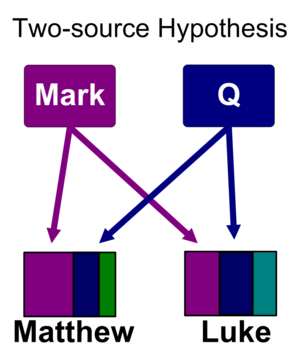Two-source hypothesis facts for kids
The Two-source hypothesis is a big idea from the 1800s. It helps explain a puzzle in Christianity called the synoptic problem. This puzzle is about why parts of the Gospel of Mark, Matthew, and Luke are so much alike.
This idea suggests that the Gospels of Matthew and Luke were written using two main sources. One source was the Gospel of Mark. The other was a lost collection of writings called "Q." The letter "Q" comes from the German word Quelle, which means "source." This "Q" document was probably a collection of things Jesus said, written in Ancient Greek. Many experts who study the Bible agree with this idea.
Contents
Understanding the Synoptic Problem
The word "synoptic" means "seeing together." The Gospels of Matthew, Mark, and Luke are called the Synoptic Gospels because they tell many of the same stories about Jesus. They often use similar words and even the same order of events.
Why the Gospels Are Similar
Imagine three friends writing about the same trip. They might all mention the same places and events. But they might also add their own details or leave some things out. The Synoptic Gospels are a bit like this.
- Mark: Many scholars believe Mark was written first. It's shorter and tells a fast-paced story.
- Matthew: This Gospel includes almost everything from Mark. It also adds many teachings of Jesus, like the Sermon on the Mount.
- Luke: Luke also uses much of Mark's content. It includes unique stories, especially about Jesus's birth and his kindness to all people.
The Two-source hypothesis tries to explain how Matthew and Luke could be so similar to Mark, yet also have their own special parts.
The "Q" Document
The "Q" document is a very important part of the Two-source hypothesis. It's a source that no one has ever found.
What Was "Q"?
Experts believe "Q" was mostly a list of sayings and teachings from Jesus. It probably did not include many stories about his life or miracles. Matthew and Luke both share many of these sayings, but Mark does not. This is why scholars think "Q" existed.
Why Is "Q" Important?
If "Q" existed, it would help explain why Matthew and Luke have so much shared material that isn't in Mark. It suggests that early Christians collected Jesus's words even before full Gospels were written.
Challenges to the Hypothesis
Even though many scholars accept the Two-source hypothesis, there are still some questions about it.
Minor Agreements
Sometimes, Matthew and Luke agree on a small detail, but Mark does not. This is called a "minor agreement." For example, they might use the exact same word or phrase where Mark uses something different. To explain this, some people think Matthew and Luke might have used an earlier version of Mark's Gospel. Or, they might have changed Mark's text a little bit.
Missing "Q" Document
One of the biggest challenges is that no one has ever found a copy of the "Q" document. It's not mentioned in any old Christian writings that we know of. This means "Q" is a theoretical source. It's an idea that helps explain the puzzle, but we don't have physical proof of it.
Despite these challenges, the Two-source hypothesis remains a popular way to understand how the Gospels of Matthew, Mark, and Luke are connected.
See also
 In Spanish: Teoría de las dos fuentes para niños
In Spanish: Teoría de las dos fuentes para niños


